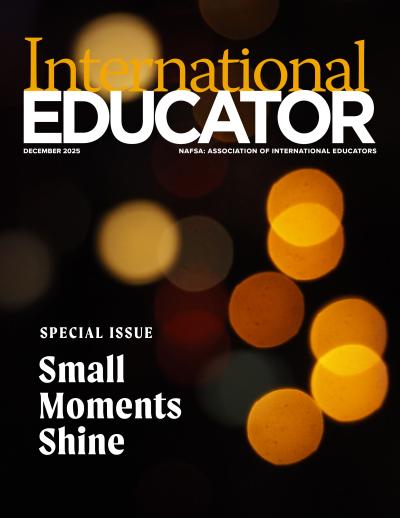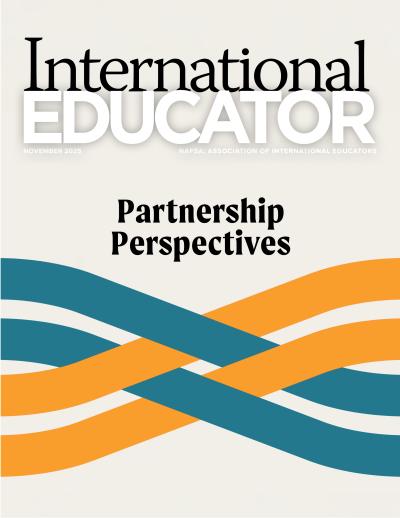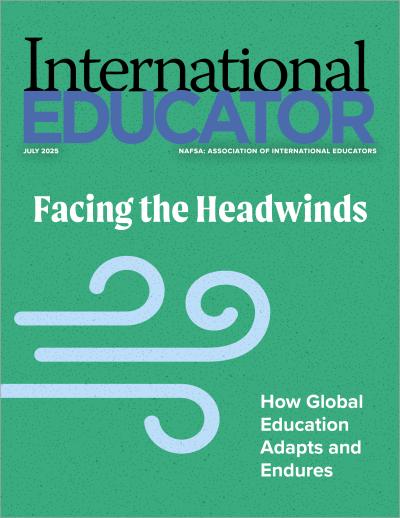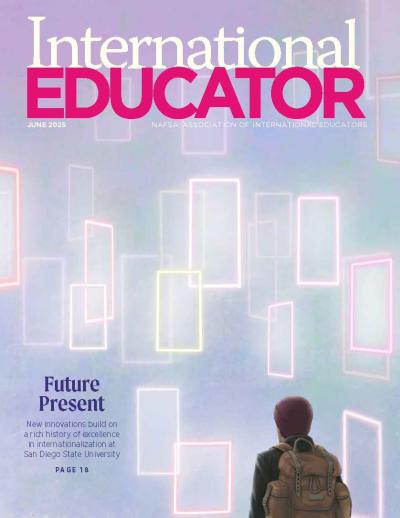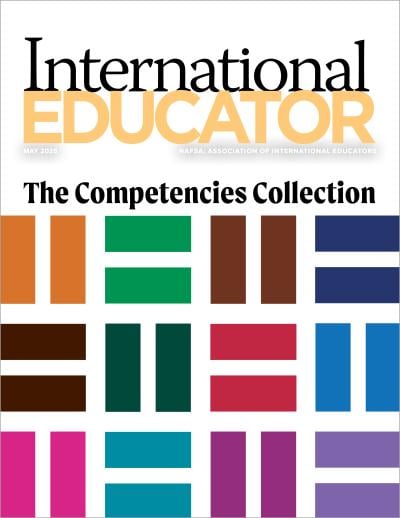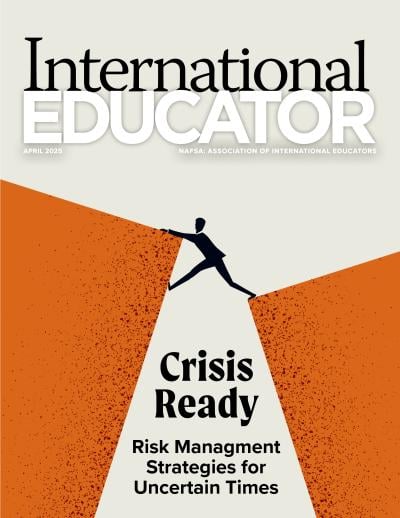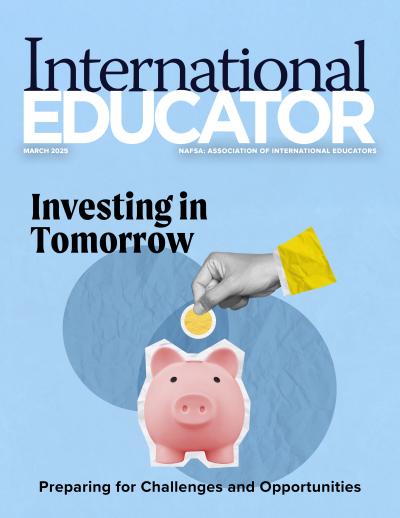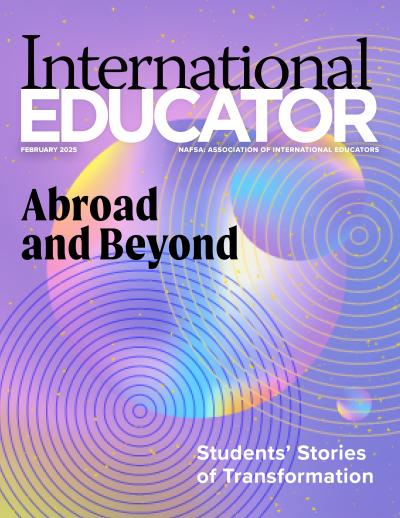Voices Carry

As a graduate student, Russell Ganim’s struggles trying to pay a $400 fee on time got him involved in student advocacy. Now associate provost and dean of international programs at the University of Iowa, he supports international students who are calling for mental health resources, changes to English-language placement testing, and, yes, the timing of when certain fees are due. These student advocacy efforts, he says, help improve the international student experience—and are in themselves an integral part of their education.
“One of our goals for international students—and all students—is to train them to be leaders and advocate for themselves,” Ganim says. “Their stories need to be told, and their problems need to be heard and resolved to the extent that this is possible. The type of learning experience involved for faculty, students, and administrators is always enriching.”
Many international offices have created structures for student advocacy and dialogue with these offices and institutions’ administrations. With names like international student advisory boards (ISABs), international student councils, and international student support boards, these groups can help “keep the university accountable and responsive to international students and their concerns,” as the web page for the ISAB at George Mason University’s (GMU) puts it. The university’s ISAB serves as “a bridge between the international student population and our office,” says Yali Pan, associate director for engagement and assessment for GMU’s Office of International Programs and Services.
Advocacy can also help improve international offices and the services they provide. For example, the University of Florida’s online predeparture orientations and the Friendship Families Holiday Program, an initiative that connects international students with local households during U.S. holidays such as Thanksgiving and the winter holidays, both came about due to advocacy by the university’s International Student Council (ISC), according to Marta Wayne, dean of the university’s International Center and associate provost. “The ISC noted that students wanted more opportunities to experience U.S. culture,” says Wayne.
“One of our goals for international students—and all students—is to train them to be leaders and advocate for themselves.” —Russell Ganim
In responding to student advocacy initiatives, international office leaders are often called on to serve as mediators—a role that requires careful listening, coordination with other university stakeholders, and, at times, the ability to strike a balance between student desires, institutional policy, and international office capacity. In managing this balance, there are some reliable strategies leaders employ.
Provide avenues for all international students to participate.
International office leaders stress the importance of representing the full spectrum of international students—not only undergraduate and graduate students but also those from different campuses and programs as well as different countries of origin. At GMU, for example, all 3,800 current international students receive an email encouraging them to apply to serve on the ISAB. In recent years, alumni members have also been added to the board to provide insight into the postgraduation experience, particularly for students trying to navigate job searches, status limitations, and the complexities of visa sponsorship.
Broad-based representation can surface student concerns that would otherwise remain unrecognized by international offices. Ensuring that international students from all of GMU’s campuses—three of which are in Virginia and one in South Korea—were on the ISAB helped administrators learn that students who were not on the main campus felt they didn’t have access to as many activities and programs, according to Pan.
Ensure international students are represented in other campus governance structures.
Iowa’s decade-old ISAB, for example, has built formal liaisons with other campus student leadership groups, including the undergraduate and graduate/professional student government bodies. Doing so has helped raise the visibility of the university’s 2,100 international students and scholars and ensure that their needs are heard, according to Ganim.
The University of Florida International Student Council’s charge includes ongoing communication with student government, the International Center, and the university’s administration, according to Wayne. And other campus organizations—including the university’s area studies centers for African, European, and Latin American studies and the Graduate Student Council—intentionally incorporate international student voices. “Many other colleges and departments also involve students in various roles in governance,” she says.
Less formal connections can also be fruitful. At GMU, concerns raised by ISAB members about international students’ introduction to academic integrity standards led to collaborations with student government and the university’s Office of Academic Integrity to ensure orientation materials were easier to digest for students for whom English isn’t a first language, according to Pan.
Understand your role as an international education leader.
“It’s very important for those of us in leadership roles to connect with the ISAB on a consistent basis,” Ganim says. “I’m not there to say no; I’m there to say, 'Let’s see what we can do.’”
At the same time, it’s important to give student advocacy leaders the ability to gather information from other international students without looking over their shoulders. At GMU, the ISAB is planning a coffee and cookie gathering with international students to discuss the services the Office of International Programs and Services provides. “Our office is not present, so students can raise concerns and suggestions,” Pan says.
“I’m not there to say no; I’m there to say, 'Let’s see what we can do.’” —Russell Ganim
Once needs are surfaced, administrators’ role is to serve as a connector. For example, addressing Iowa international student concerns about fees due at the beginning of the semester involved connections with the university’s billing and registrar’s offices, according to Ganim. The Graduate Student Employment Committee was also looped into discussions.
At times, concerns raised by students should lead to the creation of new structures. Pointing to growing numbers of international students who are accessing food pantries and requesting emergency loans, Iowa created an international student financial stress subcommittee to gather information and issue recommendations. The subcommittee is composed of international students, faculty, and representatives of the ISAB.
Encourage student advocates to be part of the solution.
In many cases, student advocates have cited the need to increase the profile or recognition of international students on campus, which they can work to make a reality.
At GMU, for example, ISAB members volunteered to speak at a panel discussion of their own design during orientation, with topics ranging from on-campus employment to how to interact with faculty and what to do for fun. And Iowa’s ISAB organizes a wide range of events, including a multicultural showcase held during international week at the university.
Embrace “no” as a learning opportunity.
One of the trickiest parts of serving as a mediator is telling student advocates what cannot change, whether that’s due to policy, budget limitations, or staff bandwidth issues.
“We acknowledge the value of student advice, but we have to do a reality check,” says Pan. For example, a suggestion to implement one-to-one peer advising at GMU ran into logistical issues and concerns about peers not having accurate information about the complexities of immigration policy. So, Pan made the request a teaching moment, asking students to consider timeline and feasibility issues. “When they go to that stage, they realize that some parts of this take a long time,” she says.
Wayne agrees. “One of the roles of the ISC is to help students understand where decisions come from and why they are made. We can also clarify misunderstandings,” she says. “I think it always helps when people know the ‘why’ behind policies, especially when they don’t agree with them.”
“We can, at a minimum, listen to the students, hear their perspectives, and show respect,” —Marta Wayne
Another teaching moment, according to Ganim, involves demonstrating the art of flexibility and compromise in improving conditions. “We don’t live in a perfect world. For example, we can’t eliminate fees,” he says. “What I’ve learned is that there’s usually room for negotiation around the margins, a way to work within the rules in a different way so we can make progress.”
Listen.
Above all, it’s important not to minimize student concerns, regardless of feasibility. “We can, at a minimum, listen to the students, hear their perspectives, and show respect,” Wayne says.
Even when students are critical of the institution and the international office itself, it’s important to acknowledge that their voices do carry—and should be heard.
“You can make meaningful changes in the international student experience and hence student success and satisfaction, and the students are so appreciative someone is listening,” Wayne says. “We’re incredibly fortunate to have the intellectual talent of our international students, as well as their diverse life experiences that enrich and internationalize our campuses. We can and should honor these contributions by intentionally seeking out and responding to international student voices.” •
NAFSA Resources
- Collegial Conversation: Celebrating Student and Alumni Success Stories
- Network.NAFSA blog post: "Quick Wins with Data: How ISSS Offices Can Demonstrate the Value of International Education on Campuses"
- Trends & Insights: "Universities as Global Villages: Supporting International Students on Campus" by Santiago Castiello-Gutiérrez and Kelber Tozini
About International Educator
International Educator is NAFSA’s flagship publication and has been published continually since 1990. As a record of the association and the field of international education, IE includes articles on a variety of topics, trends, and issues facing NAFSA members and their work.
From in-depth features to interviews with thought leaders and columns tailored to NAFSA’s knowledge communities, IE provides must-read context and analysis to those working around the globe to advance international education and exchange.
About NAFSA
NAFSA: Association of International Educators is the world's largest nonprofit association dedicated to international education and exchange. NAFSA serves the needs of more than 10,000 members and international educators worldwide at more than 3,500 institutions, in over 150 countries.
NAFSA membership provides you with unmatched access to best-in-class programs, critical updates, and resources to professionalize your practice. Members gain unrivaled opportunities to partner with experienced international education leaders.





